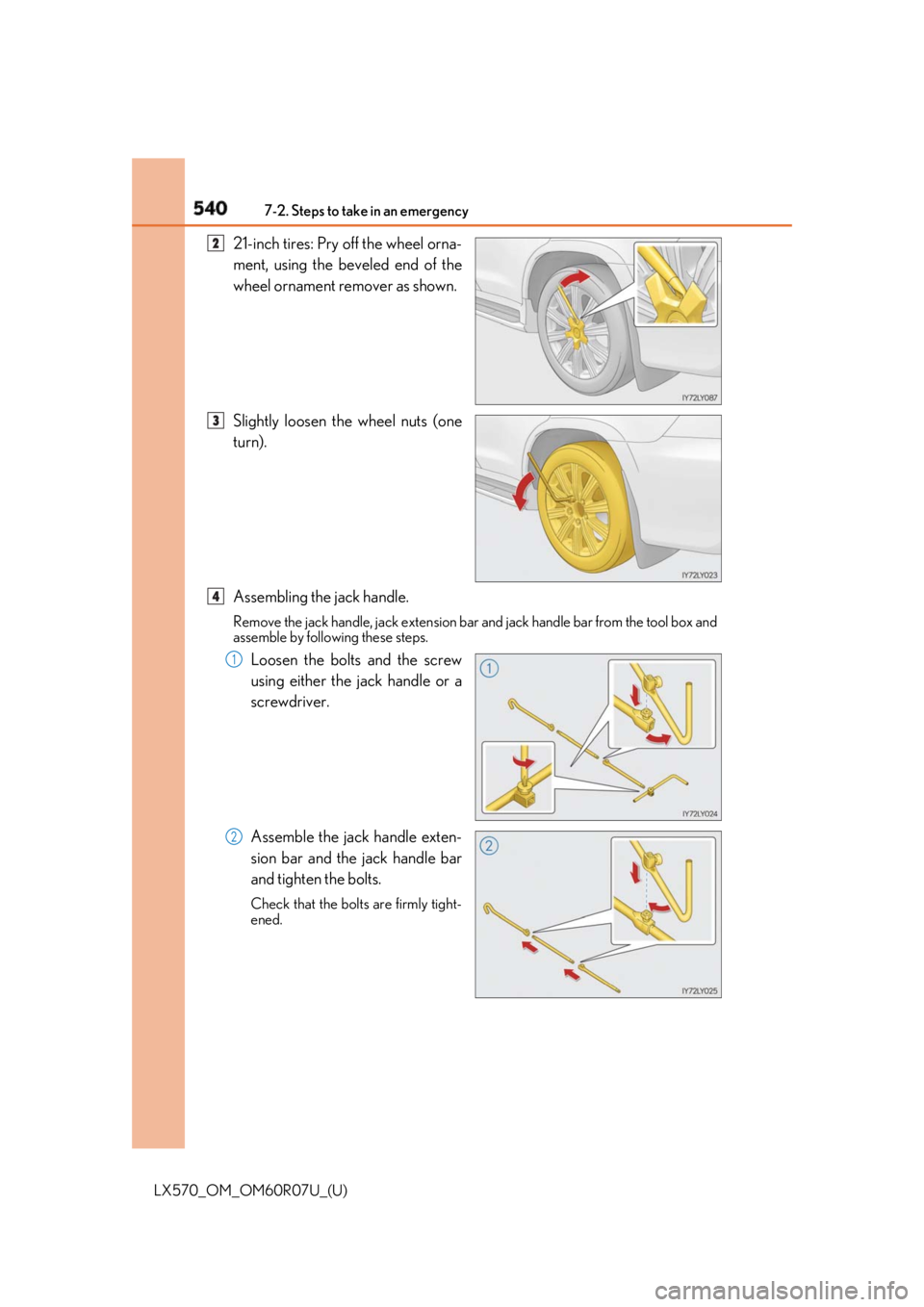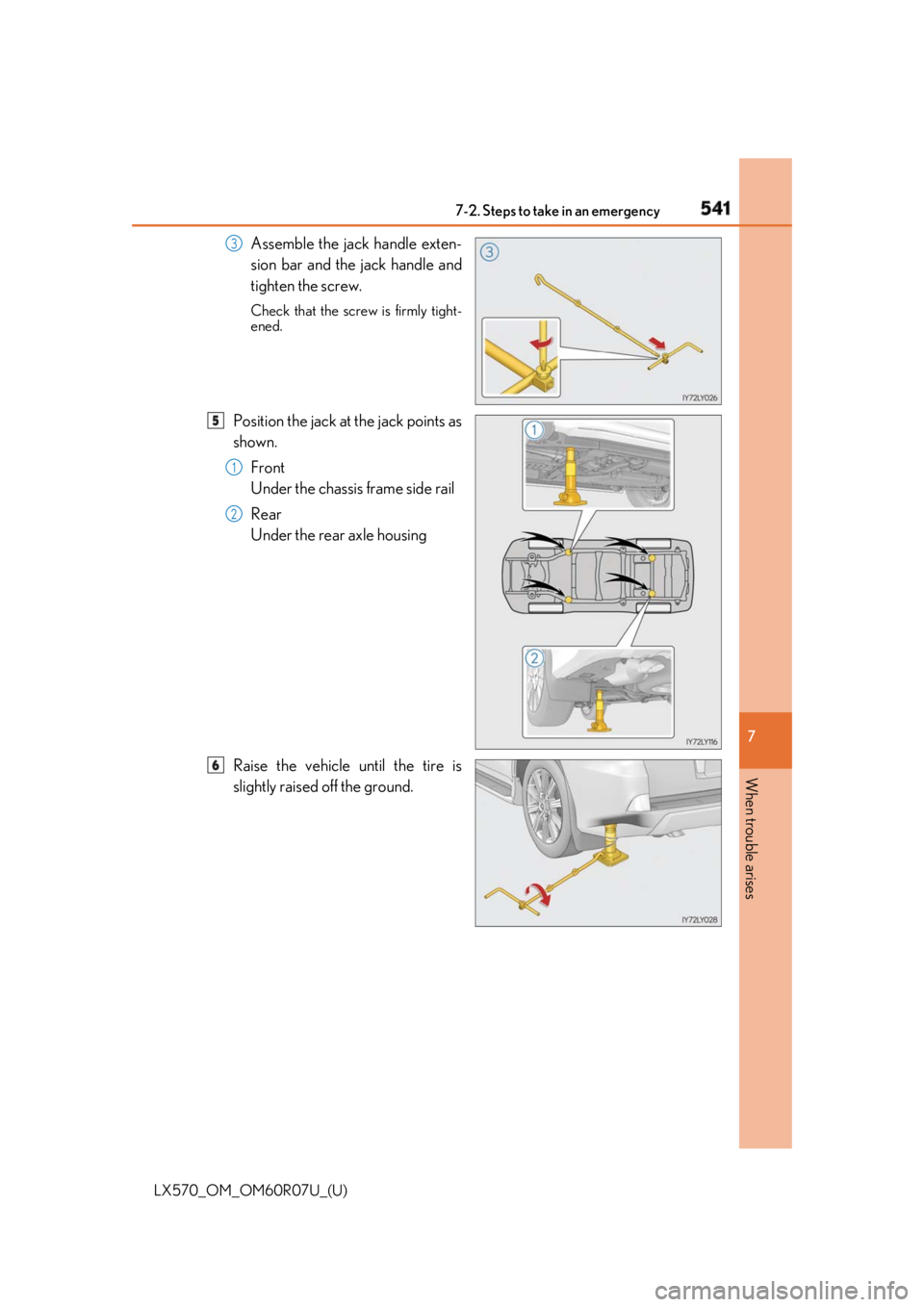Jack LEXUS LX570 2019 Owners Manual
[x] Cancel search | Manufacturer: LEXUS, Model Year: 2019, Model line: LX570, Model: LEXUS LX570 2019Pages: 632, PDF Size: 10.34 MB
Page 203 of 632

LX570_OM_OM60R07U_(U) 2034-1. Before driving
4
Driving Your vehicle will handle differently when towing a trailer. Help to avoid an acci-
dent, death or serious injury, keep the following in mind when towing:●
Speed limits for towing a tr ailer vary by state or province. Do not exceed the
posted towing speed limit. ●
Lexus recommends that the vehicle-traile r speed limit is 65 mph (104 km/h)
on a flat, straight, dry road. Do not exce ed this limit, the posted towing speed
limit or the speed limit for your trailer as set forth in your trailer owner’s man-
ual, whichever is lowest. Instability of the towing vehicle-trailer combination
(trailer sway) increases as speed incr eases. Exceeding speed limits may cause
loss of control. ●
Before starting out, check the trailer lights, tires and the vehicle-trailer con-
nections. Recheck after driving a short distance. ●
Practice turning, stopping and reversing with the trailer attached in an area
away from traffic until you become acc ustomed to the feel of the vehicle-
trailer combination. ●
Reversing with a trailer attached is di fficult and requires practice. Grip the
bottom of the steering wheel and move your hand to the left to move the
trailer to the left. Move your hand to the right to move the trailer to the right.
(This is generally opposite to reversing without a trailer attached.) Avoid sharp
or prolonged turning. Have someone gu ide you when reversing to reduce the
risk of an accident. ●
As stopping distance is increased when towing a trailer, vehicle-to-vehicle dis-
tance should be increased. For each 10 mph (16 km/h) of speed, allow at least
one vehicle and trailer length. ●
Avoid sudden braking as you may skid, re sulting in the trailer jackknifing and
loss of vehicle control. This is especi ally true on wet or slippery surfaces.Trailer towing tips
Page 208 of 632

208
LX570_OM_OM60R07U_(U) 4-1. Before driving
WARNING ■
Trailer towing precautions ●
To tow a trailer safely, use extreme care an d drive the vehicle in accordance with the
trailer’s characteristics and operating condit ions. Failure to do so could cause an acci-
dent resulting in death or serious injury. Vehicle stability and braking performance are
affected by trailer st ability, brake setting and performanc e, and the hitch. Your vehicle
will handle differently when towing a trailer. ●
Set the vehicle height to the “LO” mode and turn off the 4-Wheel AHC when you
connect a trailer, otherwise the vehicle height may change due to the automatic level-
ing function, and you may catch part of your body in the vehicle, resulting in an acci-
dent. ( P. 301)■
To avoid accident or injury ●
Do not exceed the TWR, unbraked TWR, GCWR, GVWR or GAWR. ●
If the gross trailer weight is over 2000 lb. (907 kg), a sway control device with suffi-
cient capacity is required. ●
If the gross trailer weight is over 5000 lb. (2268 kg), a weight distributing hitch with
sufficient capacity is required. ●
Adjust the tongue weight within the approp riate range. Place heavier loads as close
to the trailer axle as possible. ●
Do not exceed 65 mph (104 km/h), the posted towing speed limit or the speed limit
for your trailer as set forth in your trai ler owner’s manual, whichever is lowest. Slow
down sufficiently before making a turn, in crosswinds, on wet or slippery surface, etc.
to help avoid an accident. If you experien ce a vehicle-trailer in stability from reducing
a certain speed, slow down and make sure you keep your vehicle speed under the
speed of which you expe rience the instability.●
Do not make jerky, abrupt or sharp turns. ●
Do not apply the brakes suddenly as you ma y skid, resulting in jackknifing and loss of
vehicle control. This is especially true on wet or slippery surfaces.●
Do not exceed the trailer hitch assembly weight, gross vehicle weight, gross axle
weight and trailer tongue weight capacities. ●
Do not use cruise control (if equipped) or dynamic radar cruise control with full-
speed range (if equipped) when trailer towing. ●
Slow down and downshift before descending steep or long downhill grades. Do not
make sudden downshifts while descending steep or long downhill grades. ●
Vehicle-trailer instability is more likely on steep long down hills. Before descending
steep or long downhill grades, slow down and downshift. Do not make sudden down-
shifts when descending steep or long do wnhill grades. Avoid ho lding the brake pedal
down too long or applying the brakes too frequently. This could cause the brakes to
overheat and result in reduced braking efficiency.
Page 307 of 632

LX570_OM_OM60R07U_(U) 3074-5. Using the driving support systems
4
Driving WARNING ■
When switching the vehicle height mode
Before lowering the vehicle height, check that there are no people under or around the
vehicle, and check for obstacles.
If you do not do this, body parts may be ca ught in the vehicle, possibly leading to an
accident. ■
Using the high mode
The high mode should only be used when driving on rough roads, for example when
driving off-road. Because the vehicle’s center of gravity will become higher when in the
mode, the vehicle may become unstable when turning abruptly, resulting in an acci-
dent. ■
When jacking up the vehicle or installing tire chains
Turn off the height control and stop the engine, otherwise the vehicle height may
change due to the automatic leveling function and you may catch part of your body in
the vehicle, resulting in an accident. ■
When crossing rivers
Select the high mode and turn off the heig ht control. Drive at 18 mph (30 km/h) or
lower. Otherwise the vehicle height may change due to the automatic leveling function,
resulting in an accident. ■
If your vehicle must be towed
Put the vehicle height in the normal mode and turn off the height control, otherwise the
vehicle height may change due to the automatic leveling function and you may catch
part of your body in the vehi cle, resulting in an accident.■
If your vehicle becomes stuck in a ditch
Turn off the height control, otherwise the vehicle height may change due to the auto-
matic leveling function, re sulting in an accident.■
When loading cargo on the roof luggage carrier
Do not switch to high mode. Sudden steering could cause the vehicle to lose stability
due to the vehicle’s higher center of gr avity, possibly leading to an accident.
Page 473 of 632

LX570_OM_OM60R07U_(U) 4736-3. Do-it-yourself maintenance
6
Maintenance and care WARNING
The engine compartment contains many mechan isms and fluids that may move suddenly,
become hot, or become electrically energize d. To avoid death or serious injury, observe
the following precautions: ■
When working on the engine compartment ●
Keep hands, clothing and tools away from the moving fan and engine drive belt.●
Be careful not to touch the engine, radiator, exhaust manifold, etc. right after driving
as they may be hot. Oil and other fluids may also be hot. ●
Do not leave anything that may burn easily, such as paper or rags, in the engine com-
partment. ●
Do not smoke, cause sparks or expose an open flame to fuel or the battery. Fuel and
battery fumes are flammable. ●
Be extremely cautious when working on the battery. It contains poisonous and corro-
sive sulfuric acid. ■
When working near the electric cooling fans or radiator grille
Be sure the engine switch is off. With the engine switch in IGNITION ON mode, the
electric cooling fans may auto matically start to run if the air conditioning is on and/or
the coolant temperature is high. ( P. 481) ■
When working on or under the vehicle
Do not get under the vehicle with just the jack supporting it.
Always use automotive jack stands or other solid supports. ■
Safety glasses
Wear safety glasses to prevent flying or falling material, flui d spray, etc. from getting in
your eyes.
NOTICE ■
If you remove the air cleaner filter
Driving with the air cleaner f ilter removed may cause excessive engine wear due to dirt
in the air.
Page 535 of 632

535
LX570_OM_OM60R07U_(U) 7
When trouble arises 7-2. Steps to take in an emergency
If you have a flat tire ●
Stop the vehicle in a safe pl ace on a hard, flat surface.●
Set the parking brake. ●
Shift the shift lever to “P”. ●
Turn off the 4-Wheel AHC. ( P. 301)●
Stop the engine. ●
Turn on the emergency flashers.Your vehicle is equipped with a spare tire. The flat tire can be replaced with
the spare tire.
For details about tires: P. 488WARNING ■
If you have a flat tire
Do not continue driving with a flat tire.
Driving even a short distance with a flat ti re can damage the tire and the wheel beyond
repair, which could re sult in an accident.
Before jacking up the vehicle
Location of the spare tire, jack and tools
Jack
Spare tire Tool box1
2 3
Page 536 of 632

536 7-2. Steps to take in an emergency
LX570_OM_OM60R07U_(U) WARNING ■
Using the tire jack
Improper use of the tire jack may lead to death or serious injuries due to the vehicle
suddenly falling off the jack. ●
Do not use the tire jack for any purpose ot her than replacing tires or installing and
removing tire chains. ●
Only use the tire jack that comes with this vehicle for replacing a flat tire.
Do not use it on other vehicles, and do no t use other tire jacks for replacing tires on
this vehicle. ●
Always check that the tire jack is securely set to the jack point.●
Be sure to turn off the 4-Wh eel AHC and stop the engine.●
Do not put any part of your body under the vehicle supported by a jack. ●
Do not start or run the engine while yo ur vehicle is supported by the jack.●
Do not raise the vehicle while someone is in it. ●
When raising the vehicle, do not pu t an object on or under the jack.●
Do not raise the vehicle to a height greater than that required to replace the tire. ●
Use a jack stand if it is necessary to get under the vehicle.
Take particular care when lowering the ve hicle to ensure that no one working on or
near the vehicle will be injured. ■
Using the jack handle
Tighten all the jack handle bo lts securely using a Phillips-he ad screwdriver, to prevent
the extension parts from co ming apart unexpectedly.
Page 537 of 632

5377-2. Steps to take in an emergency
LX570_OM_OM60R07U_(U) 7
When trouble arises Remove the cover.
Unhook the rubber band and take
out the jack.
Loosen
Tighten
Loosen and remove the jack.
Remove the cover.
Take out the tool box.Taking out the jack 1
2
1
2
Taking out the tool box 1
2
Page 538 of 632

538 7-2. Steps to take in an emergency
LX570_OM_OM60R07U_(U) Assembling the jack handle. Remove the jack handle and the jack extens ion bar from the tool box and assemble by
following these steps.
Loosen the screw using a screw-
driver.
Assemble the jack handle and the
jack handle extension bar and
tighten the screw. Check that the screw is firmly tight-
ened.
Open the cover.
Insert the jack handle extension into
the lowering screw.
Lower
Raise Place a rag under the jack handle
extension to protect the back door.Taking out the spare tire 1
1
2
2
3
1
2
Page 540 of 632

540 7-2. Steps to take in an emergency
LX570_OM_OM60R07U_(U) 21-inch tires: Pry off the wheel orna-
ment, using the beveled end of the
wheel ornament remover as shown.
Slightly loosen the wheel nuts (one
turn).
Assembling the jack handle. Remove the jack handle, jack extension bar and jack handle bar from the tool box and
assemble by following these steps.
Loosen the bolts and the screw
using either the jack handle or a
screwdriver.
Assemble the jack handle exten-
sion bar and the jack handle bar
and tighten the bolts. Check that the bolts are firmly tight-
ened. 2
3
4
1
2
Page 541 of 632

5417-2. Steps to take in an emergency
LX570_OM_OM60R07U_(U) 7
When trouble arises Assemble the jack handle exten-
sion bar and the jack handle and
tighten the screw. Check that the screw is firmly tight-
ened.
Position the jack at the jack points as
shown.
Front
Under the chassis frame side rail
Rear
Under the rear axle housing
Raise the vehicle until the tire is
slightly raised off the ground. 3
5
1
2
6